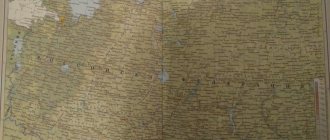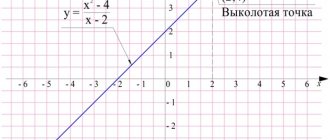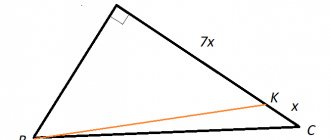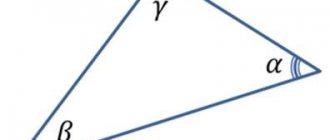Independent work on the topic Arithmetic progression, grade 9
Independent work on the topic “Arithmetic progression”
1 option
- The sequence (an) is given by the conditions a1=3, an + 1=an+4. Find a10.
- The sequence is given by the conditions c1=− 1, cn + 1=cn−1. Find c7.
- The arithmetic progression is given by the condition an=3.8−5.7n. Find a6.
- Several consecutive terms of the arithmetic progression are written out: ...; − 9; x; − 13; − 15; ... Find the term of the progression labeled x.
- Given an arithmetic progression (an), for which a10=19, a15=44. Find the progression difference.
- Several consecutive terms of the arithmetic progression are written out: 25; 19; 13; ... Find the first negative term of this progression.
- The first few terms of the arithmetic progression are written out: 20; 17; 14; ... What number is in 91st place in this arithmetic progression?
- There are 24 seats in the first row of the cinema, and each next row has 2 more seats than the previous one. How many seats are in the eighth row?
- The figure is made up of squares as shown in the figure: each next line has 8 more squares than the previous one. How many squares are there in the 16th line?
- The first few terms of the arithmetic progression are written out: 1; 3; 5; ... Find the sum of its first seventy terms
- Given an arithmetic progression (an), the difference of which is − 2.5, a1=− 9.1. Find the sum of its first 15 terms.
- The arithmetic progression is given by the condition an=− 0.6+8.6n. Find the sum of its first 10 terms.
- The arithmetic progression (an) is given by the conditions a1=− 12, an + 1=an+12. Find the sum of its first 7 terms.
Independent work on the topic “Arithmetic progression”
Option 2
- The sequence (an) is given by the conditions a1=5, an + 1=an+3. Find a10.
- The sequence is given by the conditions c1=− 2, cn + 1=cn−2. Find c11.
- The arithmetic progression is given by the condition an=− 1,1−5,6n. Find a15.
- Several consecutive terms of the arithmetic progression are written out: ...; 12; x; 6; 3; ... Find the term of the progression labeled x.
- Given an arithmetic progression (an), for which a6 =− 7.8, a19 =− 10.4. Find the progression difference.
- Several consecutive terms of the arithmetic progression are written out: − 26; − 20; − 14; ... Find the first positive term of this progression.
- The first few terms of the arithmetic progression are written out: − 9; − 5; − 1; ... What number is in 91st place in this arithmetic progression?
- The first few terms of the arithmetic progression are written out: 6; 10; 14; ... Find the sum of its first fifty terms.
- There are 50 seats in the first row of the cinema, and each next row has 1 more seats than the previous one. How many seats are there in the seventh row?
- The figure is made up of squares as shown in the figure: each next line has 8 more squares than the previous one. How many squares are there in the 34th line?
- Given an arithmetic progression (an), the difference of which is 0.6, a1=6.2. Find the sum of its first 13 terms.
- The arithmetic progression is given by the condition an=1.9−0.3n. Find the sum of its first 15 terms.
- The arithmetic progression (an) is given by the conditions a1=− 9, an + 1=an+4. Find the sum of its first 16 terms.
Independent work on the topic “Arithmetic progression”
Option 3
- The sequence (an) is given by the conditions a1=3, an + 1=an−4. Find a10.
- The sequence is given by the conditions c1=− 2, cn + 1=cn−1. Find c10.
- The arithmetic progression is given by the condition an=− 7.9+7.8n. Find a14.
- Several consecutive terms of the arithmetic progression are written out: ...; 1; x; − 5; − 8; ... Find the term of the progression labeled x.
- Given an arithmetic progression (an), for which a5=24, a15=94. Find the progression difference.
- Several consecutive terms of the arithmetic progression are written out: 33; 25; 17; ... Find the first negative term of this progression.
- The first few terms of the arithmetic progression are written out: − 4; 2; 8; ... What number is in 81st place in this arithmetic progression?
- There are 22 seats in the first row of the cinema, and each next row has 2 more seats than the previous one. How many seats are there in the twelfth row?
- The figure is made up of squares as shown in the figure: each next line has 4 more squares than the previous one. How many squares are there in the 12th line?
- The first few terms of the arithmetic progression are written out: 2; 6; 10; ... Find the sum of its first forty terms.
- Given an arithmetic progression (an), the difference of which is − 5.8, a1=1.8. Find the sum of its first 8 terms.
- The arithmetic progression is given by the condition an=− 5,3−4,5n. Find the sum of its first 12 terms.
- The arithmetic progression is given by the conditions a1=− 2,2, an + 1=an−1. Find the sum of its first 9 terms.
Independent work on the topic “Arithmetic progression”
Option 4
- The sequence (an) is given by the conditions a1=5, an + 1=an−3. Find a10.
- The sequence is given by the conditions c1=− 3, cn + 1=cn+3. Find c5.
- The arithmetic progression is given by the condition an=− 13.1+3.5n. Find a14.
- Several consecutive terms of the arithmetic progression are written out: ...; eleven; x; 19; 23; ... Find the term of the progression labeled x.
- Given an arithmetic progression (an), for which a3=6.9, a16=26.4. Find the progression difference.
- Several consecutive terms of the arithmetic progression are written out: − 39; − 30; − 21; ... Find the first positive term of this progression.
- The first few terms of the arithmetic progression are written out: − 6; 1; 8; ... What number is in 51st place in this arithmetic progression?
- There are 30 seats in the first row of the cinema, and each next row has 2 more seats than the previous one. How many seats are there in the fifteenth row?
- The figure is made up of squares as shown in the figure: each next line has 6 more squares than the previous one. How many squares are there in the 53rd line?
- The first few terms of the arithmetic progression are written out: 1; 3; 5; ... Find the sum of its first sixty terms.
- Given an arithmetic progression (an), the difference of which is − 2.2, a1=− 4.9. Find the sum of its first 8 terms.
- The arithmetic progression is given by the condition an=− 5,1−4,3n. Find the sum of its first 15 terms.
- The arithmetic progression is given by the conditions a1=− 43, an + 1=an+9. Find the sum of its first 12 terms.
Independent work on the topic “Arithmetic progression”
Option 5
- The sequence (an) is given by the conditions a1=3, an + 1=an+4. Find a10.
- The sequence is given by the conditions c1=− 2, cn + 1=cn+3. Find c11.
- The arithmetic progression is given by the condition an=8,2−9,3n. Find a6.
- Several consecutive terms of the arithmetic progression are written out: ...; 2; x; − 2; − 4; ... Find the term of the progression labeled x.
- Given an arithmetic progression (an), for which a10 =− 10, a16 =− 19. Find the difference of the progression.
- Several consecutive terms of the arithmetic progression are written out: − 26; − 20; − 14; ... Find the first positive term of this progression.
- The first few terms of the arithmetic progression are written out: − 17; − 14; − 11; ... What number is in 81st place in this arithmetic progression?
- There are 50 seats in the first row of the cinema, and each next row has 2 more seats than the previous one. How many seats are there in the ninth row?
- The figure is made up of squares as shown in the figure: each next line has 2 more squares than the previous one. How many squares are there in the 78th line?
- The first few terms of the arithmetic progression are written out: − 3; 1; 5; ... Find the sum of its first sixty terms.
- Given an arithmetic progression (an), the difference of which is − 3, a1=7.5. Find the sum of its first 8 terms.
- The arithmetic progression is given by the condition an=9,3−5,1n. Find the sum of its first 12 terms.
- The arithmetic progression (an) is given by the conditions a1=23, an + 1=an−15. Find the sum of its first 8 terms.
Independent work on the topic “Arithmetic progression”
Option 6
- The sequence (an) is given by the conditions a1=5, an + 1=an+3. Find a10.
- The sequence is given by the conditions c1=3, cn + 1=cn−1. Find c11.
- The arithmetic progression is given by the condition an=− 11.9+7.8n. Find a11.
- Several consecutive terms of the arithmetic progression are written out: ...; 7; x; 13; 16; ... Find the term of the progression labeled x.
- Given an arithmetic progression (an), for which a4=− 140, a10=− 236. Find the difference of the progression.
- Several consecutive terms of the arithmetic progression are written out: 33; 25; 17; ... Find the first negative term of this progression.
- The first few terms of the arithmetic progression are written out: − 8; − 1; 6; ... What number is in 51st place in this arithmetic progression?
- There are 20 seats in the first row of the cinema, and each next row has 2 more seats than the previous one. How many seats are there in the eleventh row?
- The figure is made up of squares as shown in the figure: each next line has 4 more squares than the previous one. How many squares are there in the 54th line?
- The first few terms of the arithmetic progression are written out: − 7; − 5; − 3; ... Find the sum of its first fifty terms.
- Given an arithmetic progression (an), the difference of which is 9.1, a1=− 8.1. Find the sum of its first 8 terms.
- The arithmetic progression is given by the condition an=− 12.6+7.9n. Find the sum of its first 14 terms.
- The arithmetic progression (an) is given by the conditions a1=− 16, an + 1=an−19. Find the sum of its first 17 terms.
Independent work on the topic “Arithmetic progression”
Option 7
- The sequence (an) is given by the conditions a1=3, an + 1=an−4. Find a10.
- The sequence is given by the conditions c1=4, cn + 1=cn−1. Find c10.
- The arithmetic progression is given by the condition an=− 3,2+9,1n. Find a12.
- Several consecutive terms of the arithmetic progression are written out: ...; 5; x; − 1; − 4; ... Find the term of the progression labeled x.
- Given an arithmetic progression (an), for which a4=18, a17=213. Find the progression difference.
- Several consecutive terms of the arithmetic progression are written out: − 39; − 30; − 21; ... Find the first positive term of this progression.
- The first few terms of the arithmetic progression are written out: 10; 6; 2; ... What number is in 101st place in this arithmetic progression?
- There are 35 seats in the first row of the cinema, and each next row has 1 more seats than the previous one. How many seats are in the thirteenth row?
- The figure is made up of squares as shown in the figure: each next line has 6 more squares than the previous one. How many squares are there in the 27th line?
- The first few terms of the arithmetic progression are written out: 4; 7; 10; ... Find the sum of its first sixty-five terms.
- Given an arithmetic progression (an), the difference of which is 4.7, a1=2.1. Find the sum of its first 14 terms.
- The arithmetic progression is given by the condition an=− 0.2−2.7n. Find the sum of its first 11 terms.
- The arithmetic progression is given by the conditions a1=15, an + 1=an−16. Find the sum of its first 10 terms.
Independent work on the topic “Arithmetic progression”
Option 8
- The sequence (an) is given by the conditions a1=5, an + 1=an−3. Find a10.
- The sequence is given by the conditions c1=− 6, cn + 1=cn−2. Find c8.
- The arithmetic progression is given by the condition an=− 4.1+9.8n. Find a15.
- Several consecutive terms of the arithmetic progression are written out: ...; 17; x; 13; eleven; ... Find the term of the progression labeled x.
- Given an arithmetic progression (an), for which a10 =− 2.4, a25 =− 0.9. Find the progression difference.
- Several consecutive terms of the arithmetic progression are written out: − 57; − 44; − 31; ... Find the first positive term of this progression.
- The first few terms of the arithmetic progression are written out: 30; 27; 24; ... What number is in 101st place in this arithmetic progression?
- There are 25 seats in the first row of the cinema, and each next row has 2 more seats than the previous one. How many seats are there in the sixth row?
- The figure is made up of squares as shown in the figure: each next line has 2 more squares than the previous one. How many squares are there in the 39th line?
- The first few terms of the arithmetic progression are written out: − 1; 2; 5; ... Find the sum of its first fifty-five terms.
- Given an arithmetic progression (an), the difference of which is 1.1, a1=− 7. Find the sum of its first 14 terms.
- The arithmetic progression is given by the condition an=− 14.5+8n. Find the sum of its first 12 terms.
- The arithmetic progression (an) is given by the conditions a1=37, an + 1=an+16. Find the sum of its first 17 terms.
Independent work on the topic “Arithmetic progression”
Option 9
- The sequence (an) is given by the conditions a1=3, an + 1=an+4. Find a10.
- The sequence is given by the conditions c1=1, cn + 1=cn−1. Find c8.
- The arithmetic progression is given by the condition an=− 1.5−8n. Find a12.
- Several consecutive terms of the arithmetic progression are written out: ...; − 1; x; 3; 5; ... Find the term of the progression labeled x.
- Given an arithmetic progression (an), for which a3=4.2, a15=16.2. Find the progression difference.
- Several consecutive terms of the arithmetic progression are written out: 87; 69; 51; ... Find the first negative term of this progression.
- The first few terms of the arithmetic progression are written out: 20; 13; 6; ... What number is in 81st place in this arithmetic progression?
- There are 28 seats in the first row of the cinema, and each next row has 2 more seats than the previous one. How many seats are there in the sixteenth row?
- The figure is made up of squares as shown in the figure: each next line has 4 more squares than the previous one. How many squares are there in the 65th line?
- The first few terms of the arithmetic progression are written out: − 6; − 3; 0; ... Find the sum of its first ten terms.
- Given an arithmetic progression (an), the difference of which is 5.3, a1=− 2. Find the sum of its first 9 terms.
- The arithmetic progression is given by the condition an=− 6,3+4,4n. Find the sum of its first 12 terms.
- The arithmetic progression is given by the conditions a1=2.6, an + 1=an−0.2. Find the sum of its first 13 terms.
Tasks for independent work are taken from the Open Bank of OGE tasks fipi.ru
Test on the topic: Arithmetic progression
Level: expert. 1 person is passing through right now.
0%
{an} is an arithmetic progression. Find d if a1=216, a31=-3
Correct answer Incorrect answer
The arithmetic progression {an} is given. Find a1 and d if a5=14, a24=71
Correct answer Incorrect answer
Given an arithmetic progression: -5; -2; 1; 4; 7; … . Determine the number of the term of this progression, equal to 55
Correct answer Incorrect answer
How many negative terms are there in an arithmetic progression: -23.7; -23.4; -23.1; ... ?
Correct answer Incorrect answer
Is the number -157 a member of the arithmetic progression 18; eleven; 4; -3; -10; ... ?
Correct answer Incorrect answer
Find the 111th term of the arithmetic progression {an}, if a1=312, a5=288
Correct answer Incorrect answer
Find the formula for the nth term of the arithmetic progression 24; 19; 14; 9; 4; ...
Correct answer Incorrect answer
{an} is an arithmetic progression. Find a1 if d, if a20=16 and d=-0.5
Correct answer Incorrect answer
Given an arithmetic progression for which a1=-125, d=4. Is the number 3 a member of this arithmetic progression?
Correct answer Incorrect answer
How many positive terms are there in an arithmetic progression: 17.2; 17; 16.8; ... ?
Correct answer Incorrect answer
Arithmetic progression God! Excellent knowledge of the topic “Arithmetic progression” Very good! Almost perfect knowledge of the topic “Arithmetic progression” Not bad! But it’s better to read the topic “Arithmetic progression” again on the website sprint-olympic.ru Bad! We advise you to quickly re-read the topic “Arithmetic progression” on the website sprint-olympic.ru Horrible! Urgently re-read the topic “Arithmetic progression” on the website sprint-olympic.ru
Share your results:
The Arithmetic Progression test (9th grade) with answers is compiled in accordance with the ministerial program, therefore it is an excellent assistant in the process of home preparation for classes. The questions test the ability to find members of a progression and their numbers. Some tasks relate to the theoretical basis of the section. The test covers almost the entire topic, but will take about 10 minutes to complete. The online version is available from any device.
The algebra test “Arithmetic Progression” will help you independently repeat and systematize the material for successful writing of current and final test papers.
Previous
9th gradeProgression
Next
Grade 9 Addition and subtraction of vectors
TOP 5 tests that go along with this
- Test on the topic: Present Perfect Passive Voice in English Education: 6th grade. Number of questions: 10. Difficulty level: expert.
- Test on the topic: Verb to be Education: 5th grade. Number of questions: 10. Difficulty level: expert.
- Test on the topic: Addition and subtraction of fractions Education: 8th grade. Number of questions: 10. Difficulty level: expert.
- Test on the topic: Present Perfect Continuous Education: 7th grade. Number of questions: 10. Difficulty level: beginner.
- Test on the topic: Present Perfect and Past Simple Education: 7th grade. Number of questions: 10. Difficulty level: expert.







